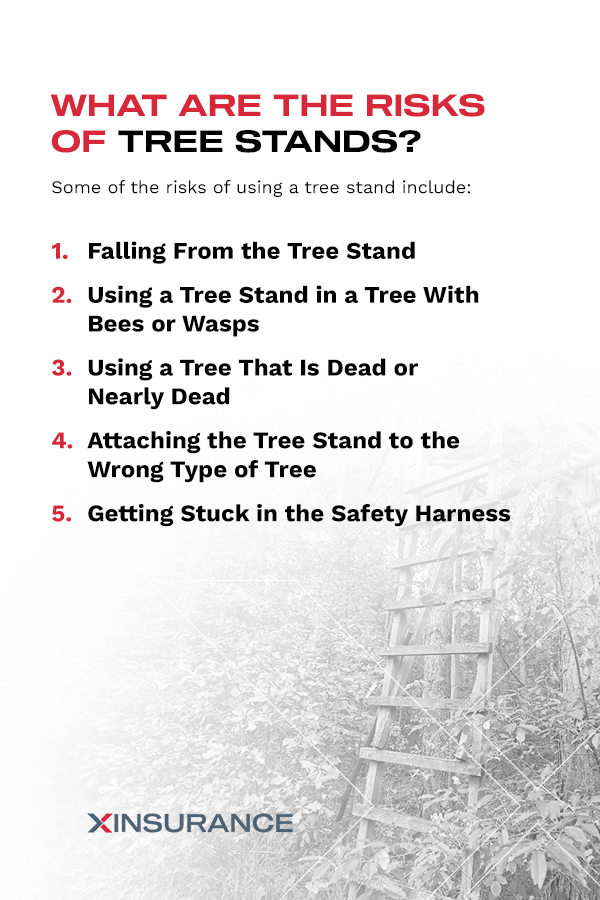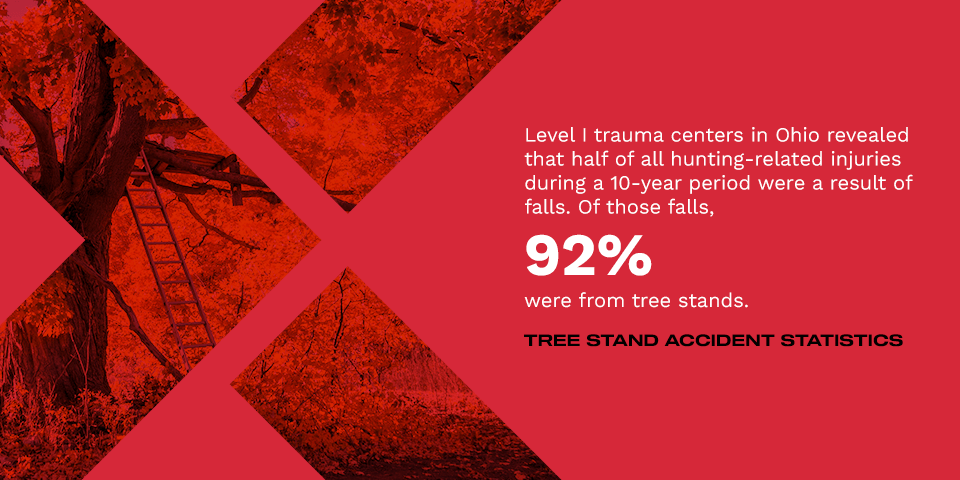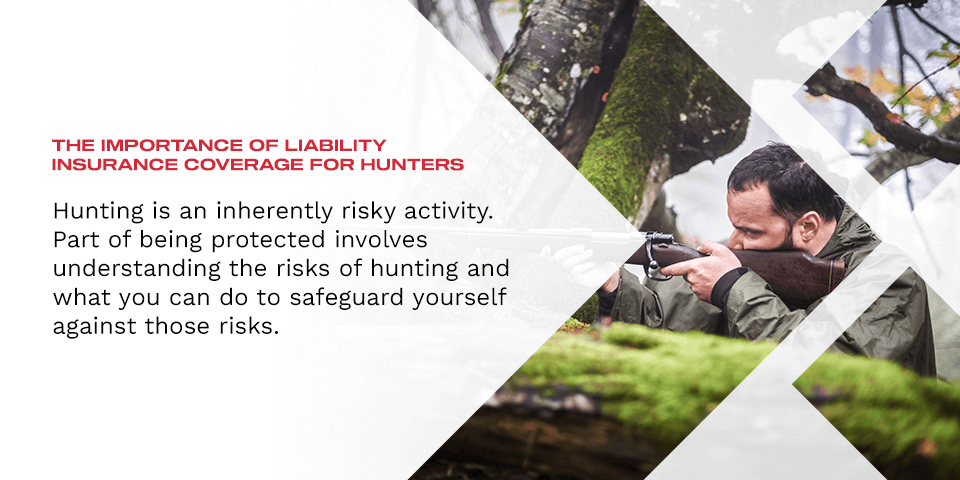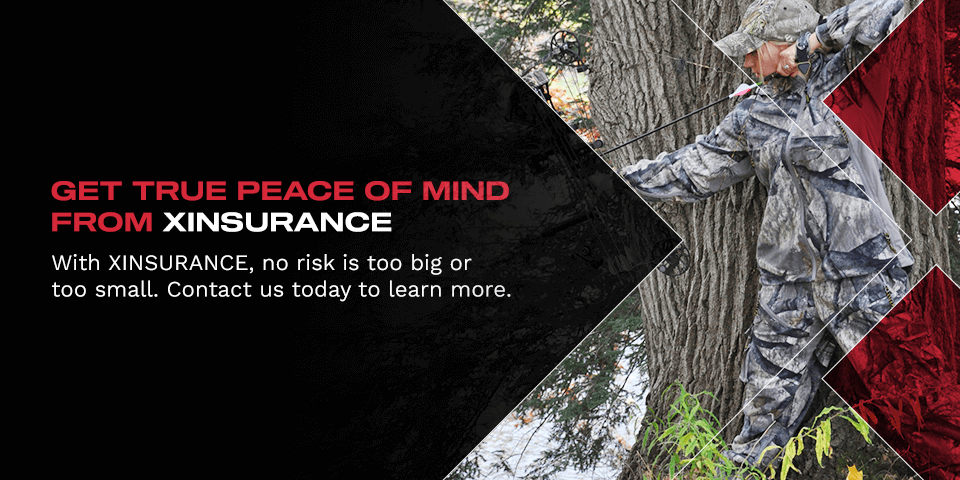
Dangers of Tree Stands for Hunting
A tree stand can give a hunter an advantage by placing them above the height of the animals they’re hunting. When a hunter is in a tree, they also have a better view of the area around them, allowing them to see deer or other animals from a considerable distance away. It’s estimated that 90% of bowhunters and 80% of firearms hunters climb tree stands when hunting. While tree stands have their benefits, they are not without risk. In fact, research has demonstrated that tree stands are responsible for more hunting-related injuries than gunshots.
Knowing how people can get injured when using tree stands and what you can do to minimize the risk of injury is essential for protecting anyone who hunts on your property. Liability insurance can provide an additional layer of protection for companies or individuals who allow people to hunt on their land. It’s also essential that individual hunters and hunting clubs have liability coverage.
What Are the Risks of Tree Stands?
A tree stand accident can occur for a variety of reasons. The tree stand itself might not be properly mounted to the tree, making it structurally unsound and unable to support the weight of a hunter. Or, the tree might be dying and unable to support the stand. Recognizing the risks and dangers of tree stands is the first step to take to protect any hunters who might be hunting on your property and using yours or their own stands.
Some of the risks of using a tree stand include:
1. Falling From the Tree Stand
Hunters can fall from tree stands for a wide range of reasons. If a hunter is on the larger side, the tree stand may not be rated for their weight and might not be able to support them. In some instances, hunters may get too bold when climbing tree stands. They can engage in dangerous activities, such as taking their feet out of the straps at the base of the tree stand, not wearing a harness or showing off “no hands” to their fellow hunting buddies.
When hunters fall from tree stands, they can be injured by more than the fall itself. Some can experience injuries from falling on a sharp branch or on part of the tree stand.
2. Using a Tree Stand in a Tree With Bees or Wasps
Bees and wasps often build their nests in trees, which can present a problem if the tree also happens to house a tree stand. A hunter who climbs the stand, oblivious to the presence of stinging insects, risks getting stung or possibly falling from the stand as they try to get away from the bugs. This danger can be compounded if the hunter is allergic to bee or wasp stings.
3. Using a Tree That Is Dead or Nearly Dead
When trees die or are in the process of dying, they often rot from the inside out. A tree might look fine from the outside, but on the inside it might not be able to support the weight of a tree stand and hunter. A dying or dead tree can also be blown over more easily in the wind, potentially taking a hunter with it.
4. Attaching the Tree Stand to the Wrong Type of Tree
It can be challenging to get a good grip or to attach a tree stand securely to certain types of trees. For example, the cores of palm trees are usually hollow, meaning that the screws used to attach the tree stand won’t get a good “bite.” When a person puts their weight on the stand, the screws can pull out from the tree, leading to a fall.
The bark of certain types of trees, such as oak or pine trees, can be thick enough to prevent the screws from reaching the wood beneath. When weight is placed on the steps of the tree stand, the bark can pull away from the tree, possibly leading to a fall.
5. Getting Stuck in the Safety Harness
Safety harnesses can protect hunters who fall from trees by breaking the fall. Unfortunately, the harness can cause something known as harness suspension trauma if the hunter remains hanging in the air for some time. The harness can cut off blood flow to the legs, causing the heart to work harder. A person’s blood pressure and heart rate can fall, and they might feel nauseated or lightheaded.
Tree Stand Accident Statistics
When people think of hunters getting injured, the scenario that often comes to mind is someone being hurt by a stray gunshot. In reality, tree stand accidents are typically responsible for the greatest number of hunting-related accidents. A review of database information from Level I trauma centers in Ohio revealed that half of all hunting-related injuries during a 10-year period were a result of falls. Of those falls, 92% were from tree stands. In contrast, wounds from gunshots made up 29% of all injuries during the same period.
Another study used data from the state of Wisconsin to examine the occurrence of falls and to determine what type of hunter is more likely to experience a fall. It found that archery hunters were nearly twice as likely to have experienced a fall compared to firearms hunters. Nearly 28% of bowhunters reported having fallen or nearly fallen, while 13% of firearms hunters reported the same. Archery hunters were more likely than firearms hunters to use a tree stand when hunting, according to the study. They were also more likely to wear a harness than firearm hunters.
The Wisconsin study suggested that the risk of a fall from a tree stand increased the more frequently a hunter used an elevated stand. An individual who hunts each season over a 30-year period has a 1 in 33 chance of falling from a tree stand. Someone who hunts each year during a 50-year period has a 1 in 20 chance of falling.
It’s possible that the number of injuries and the number of tree stand accidents are under-reported. The New York State Department of Environmental Conservation (DEC) noted that there were five incidences of people falling from a stand in 2018, and 12 such incidences in 2017 — the first year the DEC began tracking tree stand-related incidents. Unlike firearm-related injuries, which must be reported, tree stand-related injuries do not have to be.
According to the Tree Stand Safety Awareness Foundation (TSSA), certain types of tree stands were associated with more falls than other types. Lock-on types of tree stands were responsible for 31% of incidents in 2017. Climber stands were associated with 25% of falls, and ladder and homemade stands were each responsible for 20% of incidents. The TSSA strongly advises against hunters using homemade stands.
How to Prevent Accidents on Your Tree Stand
Whether you are using a tree stand on your own property or are allowing other hunters to use the stands on your land, there are several steps you can take to reduce the risk of falls and accidents and protect people if an accident does occur:
- Require the use of fall arrest systems: Fall arrest systems, such as harnesses, are a safety must-have for any hunter who wants to climb into an elevated stand. According to the TSSA, 86% of fall victims weren’t wearing harnesses. Of people who were injured in a fall, 99% were not properly attached to the fall arrest system.
- Ask hunters to climb first, then haul up their gear: Getting up into the tree stand should be a two-part process for hunters. For safety reasons, they should not try to climb up into the stand while carrying their firearm or other gear. Instead, the hunter should climb up first, then use a hoist to haul up their equipment after they are in the stand.
- Warn against using the tree stand in hazardous weather conditions: Wet, snowy or icy conditions can make tree stands precarious. When the weather is not good or when windy or icy conditions are predicted, a hunter’s safest option is to stay on the ground.
- Encourage the buddy system: There’s safety in numbers, particularly when a person is climbing 20 or 30 feet into the air. Installing a tree stand is at least a two-person job. Having another person present while hunting can also help to minimize the risk of falls. A second person can act as a spotter while a hunter climbs into the tree stand and can ensure that the harness is properly attached. If a hunter does decide to hunt solo, they should always tell at least one other person where they are and bring a cell phone or another type of communication device with them so that they can call for help.
- Ensure that the tree stand is properly installed: A tree stand that isn’t properly installed is more likely to fail and cause an accident than one that is securely attached. Proper installation of a tree stand involves choosing the right type of tree and following the instructions for installation.
- Inspect the stands before use: Hunters should check the conditions of a tree and tree stand before using it to make sure all is well. Trees that are dead or dying will typically have dry, brittle branches and few, if any, leaves. The bark covering the tree might be uneven or discolored.
How to Properly Install a Tree Stand
Along with following the manufacturer’s instructions, the most important thing you can do when installing a tree stand is to choose the right tree. The tree should be solid and shouldn’t have signs of decay. Before you start the installation process, inspect the tree for signs of nests or hives.
Trees with smooth, thin bark are usually better suited for tree stands than species with thick bark. When the bark is too thick, it’s difficult for the screws to reach the solid wood of the tree and firmly attach to it.
It’s also important to make sure that the steps of the tree stand are firmly and completely attached to the tree. You might drill pilot holes into the tree, then attach the steps with the screws to ensure they are fully driven in.
The Importance of Liability Insurance Coverage for Hunters
Hunting is an inherently risky activity. Part of being protected involves understanding the risks of hunting and what you can do to safeguard yourself against those risks. Though engaging in safe behaviors and installing your tree stands properly can offer some protection against falls and injuries, you should also purchase liability insurance designed for hunters.
For adequate protection, both the individual or company who owns the land where the hunting occurs and the individuals or hunting clubs who hunt should have liability insurance. Liability coverage for landowners may offer some protection in the case of a lawsuit. If a hunter is using a tree stand on your land and the tree stand malfunctions or the tree falls, they might bring a lawsuit against you. Having the right amount of insurance coverage and policy terms may help protect some of your company’s assets and your personal assets.
Hunters and hunting clubs also need liability insurance, especially if they are renting land to hunt on or are guests of another hunter. Liability coverage may protect hunters in a few ways. If they are hunting and accidentally shoot another person, their insurance policy may offer some financial coverage in the event of a lawsuit. If a hunter causes damage to the property on the land, liability insurance coverage can offer financial protection based on the policyholder’s limits and terms.
Individual hunters and hunting clubs can benefit from liability coverage in another way. Many private landowners who lease their land to hunters require that the individuals or clubs have liability coverage. A landowner is likely to refuse to let uninsured hunters use their land, as doing so can put too much of a burden on them.
Tips for Choosing Liability Insurance for Hunters and Landowners
There are a few things to consider when choosing a liability insurance policy:
- Coverage limit per occurrence: The amount of liability protection the policy offers per incident.
- Coverage limit in aggregate: The aggregate coverage limit is the maximum amount of coverage the policy offers over its lifespan.
- Member-to-member coverage: Also known as cross member coverage, member-to-member coverage protects the hunting club as well as individual members.
- Guest liability coverage: If a hunting club or individual hunter invites guests on a hunt, a policy that offers guest liability coverage will provide protection if the guests are injured, cause property damage or do something that causes harm to another person.
Get True Peace of Mind From XINSURANCE
Whether you own land that people use to hunt, organize a hunting club or are an individual hunter, you want hunting insurance that provides you true peace of mind. XINSURANCE takes an all-in-one approach, working with companies and individuals to create a customized insurance solution that provides coverage for all possible exposures. When you partner with us, you’ll be working directly with underwriters and decision-makers to put together a policy that works for you.
With XINSURANCE, no risk is too big or too small. Contact us today to learn more about our outdoor recreation liability insurance.

Rick J. Lindsey hails from Salt Lake City, Utah. He began working in the mailroom of his father’s Salt Lake City insurance firm, getting his introduction to the business that became his lifelong career. Rick J. Lindsey quickly rose through the ranks while working in nearly every imaginable insurance industry job. As an entrepreneur, specialty lines underwriter, claims specialist, risk manager, and a licensed surplus lines broker, Rick J. Lindsey is highly skilled in all levels of leadership and execution. As he progressed on his career path, Rick J. Lindsey discovered an urgent need for insurers willing to write policies for high-risk individuals and businesses. He was frequently frustrated that he could not provide the liability protection these entities desperately needed to safeguard their assets. He also formed the belief that insurance companies acted too quickly to settle frivolous claims. Rick J. Lindsey decided to try a different approach. He started an insurance company and became the newly formed entity’s CEO. This opportunity has enabled Rick J. Lindsey to fill a void in the market and provide a valuable service to businesses, individuals, and insurance agents who write high-risk business. XINSURANCE also specializes in helping individuals and businesses who live a lifestyle or participate in activities that make them difficult for traditional carriers to insure. If you’ve been denied, non-renewed, or canceled coverage, don’t give up quite yet. Chances are XINSURANCE can help.





